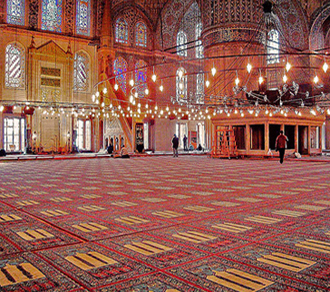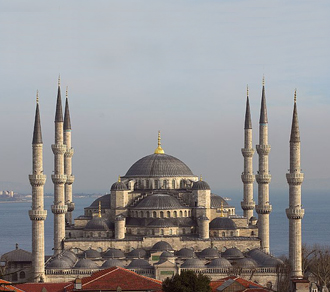| |
Located in Istanbul, Turkey, the Blue Mosque is a true architectural
wonder. Commissioned to be built in 1609 by Sultan Ahmet I, the
mosque was intended to rival the Hagia Sofia with its enormous dome.
The architect in charge of the design, Mehmet Aga, was not able to
create a larger dome for the Blue Mosque, but he did add several
innovations which made the mosque unique for its time. Until the
construction of the Blue Mosque, no other Muslim worship center had
six minarets. The legend behind this odd number of minarets - since
mosques usually have one, two or four - is that Sultan Ahmet I asked
for gold minarets using the word altin. The architect thought the
Sultan had ordered alti (six) minarets instead. When the error was
revealed, Mehmet Aga feared for his life, but the Sultan was so
enamored with the design that the architect was spared.
Even though the domes are not as large as the main dome of the
Hagia
Sofia, it is still of an impressive size, but despite the title Blue
Mosque, there is nothing blue about the exterior of the building.
The name hails from the inclusion of over 20,000 blue tiles inside.
These tiles are embedded in the walls, undersides of the domes, and
ceilings of the mosque, and they can be seen by any visitor who
wishes to look up.
The Blue Mosque proves to be a popular tourist spot, but rules of
etiquette must be followed when entering since it is still in use as
a mosque and must close five times a day for over one hour to devote
to prayers. Visitors need to remember to dress modestly, remove
their shoes, and women must cover their heads. Non-Muslims are
allowed entrance, but their entry point is limited to the north gate
while Muslims enter through the main doorway on the west side. Due
to the sacredness of the site, even when formal prayers are not
being held, visitors should remain quiet and respectful of lone
worshipers who engage in solitary prayers and devotions inside the
mosque.
A trip to the Blue Mosque is not to be missed for visitors to
Istanbul for its stunning architecture and significance.


|
|
